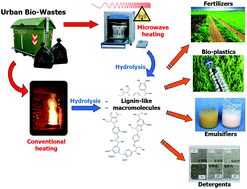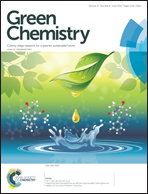Conventional and microwave assisted hydrolysis of urban biowastes to added value lignin-like products
Abstract
The hydrolysis of five fermented water insoluble urban wastes is shown to convert the insoluble recalcitrant organic lignin-like fraction to added value soluble lignin-like products in high yields. The hydrolysate products are a mixture of complex polymeric molecules which maintain the memory of the proximates of the pristine materials. For a composted biowaste, taken as the case study, a process feasibility study comparing the microwave (MW) assisted versus the conventional (CON) reaction is reported. Product yields and quality are investigated as a function of four process parameters: i.e. pH (8–13), temperature (60–200 °C), and liquid–solid w/w ratio (4 and 10) and contact time (1 min–4 h). Microwave heating allows obtaining the same products, and in the same yields, as conventional heating in 1–2 orders of magnitude lower time. It is possible to achieve 50–60% yields of soluble lignin-like products at relatively low temperatures ≤100 °C. The obtained yield vs. temperature trend indicates that even higher yields may be obtained at higher temperatures. The potential scalability of MW assisted versus CON hydrolysis to the industrial level is discussed in relation to the reaction rate and reactor cost. The results offer worthwhile research scope to compare MW and CON heating for the hydrolysis of other fermented and non-fermented material as collected biowastes.


 Please wait while we load your content...
Please wait while we load your content...